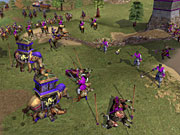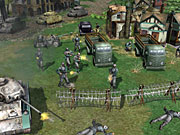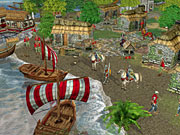Empires: Dawn of the Modern World Hands-On Impressions
We take an exclusive hands-on look at Stainless Steel Studios' upcoming real-time strategy game.
For years now, real-time strategy games have had us scrambling to collect resources, building bases, and quickly creating armies to smash our opponents before they can do likewise. Some of the most recent games of this genre have truly been exceptional, as they've presented both innovative features and extremely deep gameplay. Stainless Steel Studios is attempting to make an even more impressive game with Empires: Dawn of the Modern World--a history-themed game that will encompass 1,000 years of human history. The game will feature two entirely separate gameplay styles: epic empire-building and fast-paced head-to-head action. We recently had the opportunity to sit down and play the latest version of the game ourselves.

The game will feature five different time periods, or epochs, including such popular venues as the Middle Ages of Europe and World War II. We played a few "action" games, from each of these epochs, while in the head-to-head multiplayer mode. You start these epochs, as well as others, with a few citizens--who are essentially worker units that build structures and/or gather resources for your civilization--and a town hall structure that produces new citizens. The town hall also lets you research new global technologies that can be used to improve your civilization's economy. Technology enhancements can improve resource-gathering, encourage faster building, and so on. Many of the game's civilizations share a few basic buildings in common. These include: barracks--which produce infantry units; armories--which are used to research military upgrades; stables--which produce cavalry units; granaries--which aid in food production and gathering; universities--from which you may research the game's classified projects (powerful global effects that may be used only twice in a match); and, in later epochs, airports--which are used to recruit fighter planes, bombers, and flying personnel transports. However, these commonly shared structures all produce unique units that play different roles during the course of the game.
We saw these unit differences in action during our first multiplayer game. Our campaign took place during the Middle Ages, and we played as the Korean civilization. In Empires, the Koreans are an aggressive race who have a few unique economic advantages. Specifically, they can gather resources more quickly than other civilizations and can start new games with an exceptionally large number of citizens. However, the town hall produces citizens in an extremely slow manner. A better way to increase your economy is to defeat enemy soldiers, who immediately become bondservant citizens under your control.

And the Korean military enjoys several, powerful global bonuses that give them an edge on the battlefield during the Middle Ages. This is particularly true of its infantry units. These bonuses include the martial arts ability, which causes units to deliver more damage and lets them move more quickly, and, once you've built a temple, the zen ability, which briefly makes certain units invulnerable to damage. All special abilities are displayed onscreen as a set of icons. So, if you have a group of units selected, you can access all special abilities for any selected unit here. Then, by clicking that icon, all applicable units automatically use the ability. If you prefer, you can, of course, use hotkey shortcuts instead.
Epic Epochs
Our next multiplayer game of Empires: Dawn of the Modern World took place between World War I and WWII. We were able to pick the US in this match. The US is a civilization whose immense natural wealth grants it additional starting resources. In the early- to mid-20th century, the US is equipped with infantry units, like the Vickers MG team (a two-man unit that can entrench itself to increase its range and defenses); engineers, who can repair mechanical units and capture enemy buildings; and stealthy army rangers, who can call in artillery barrages on unsuspecting targets. Americans can also use their airports to commission fighter planes--like the P-51 Mustang--and transports--like the C-47 Skytrain. However, the most fearsome component of American air superiority is the B-29 Superfortress, which is capable of dropping extremely damaging atomic bombs on its targets.

The game's multiplayer lobby lets you quickly and easily change options, like choosing how many epochs your game will span, establishing beginning resources, and others. According to lead multiplayer designer Richard Bishop, Stainless Steel Studios is emphasizing fast-paced multiplayer games that let you quickly find opponents by using an auto-match option that will pair up players with comparable win/loss records--since the game will also track your stats online. Bishop also explained that one of his most important duties, as multiplayer designer, is making sure that the head-to-head action mode plays well. Though he and his team are supremely concerned with balancing the game (a tall order considering that all seven nations have completely different armies and technologies), the multiplayer design team at Stainless Steel is also making sure that players are afforded an exceptional level of control over their military units. Based on what we saw, it appears that these units seem to have no problem using their various special abilities on the battlefield, nor do they suffer from any serious movement problems related to physics or turning radius.
We then turned to the single-player game, which includes three separate adventures that chronicle the careers and epic battles of Richard the Lionheart (during the Middle Ages), Admiral Yi of Korea, and General Patton. The first campaign acts as a tutorial that instructs you on how to use different units by also telling the tale of the struggle for power between Richard and his brothers. The second chronicles the campaign surrounding the rise to power of the Choson dynasty and the epic battle between Admiral Yi, who used a fleet of the world's first ironclad battleships to defeat invading Japanese forces. According to Stainless Steel's Rick Goodman, a good deal of research went into each of the game's three campaigns, though the developer devoted an exceptional amount of effort and research into making sure the campaign was historically accurate. Goodman explained that the other two campaign settings, medieval England and World War II, offered the developer a bit more leeway to be creative.

Empires: Dawn of the Modern World is clearly an ambitious game that will appeal to an extremely wide audience--or so the developer hopes--and it seems to be coming along well. Goodman and company have been touring the world and showing the game off to many different audiences in many different countries. As you might expect, different audiences seem interested in different aspects of gameplay, so Goodman and his team have continued to carefully cull feedback from them all. Empires: Dawn of the Modern World is scheduled to ship later this year. For now, you can get an update directly from the source in our exclusive video interview with Stainless Steel Studios president Rick Goodman and lead multiplayer designer Richard Bishop.
Got a news tip or want to contact us directly? Email news@gamespot.com
Join the conversation